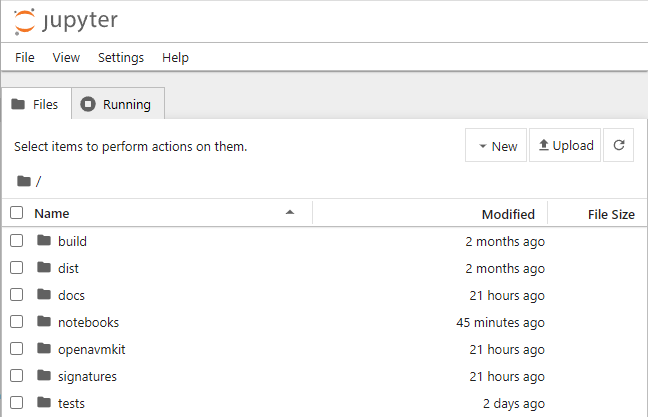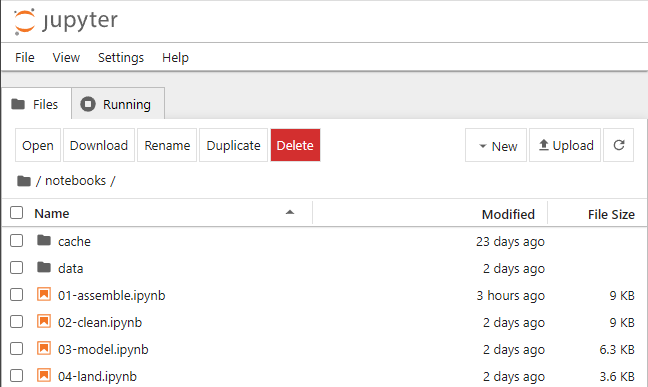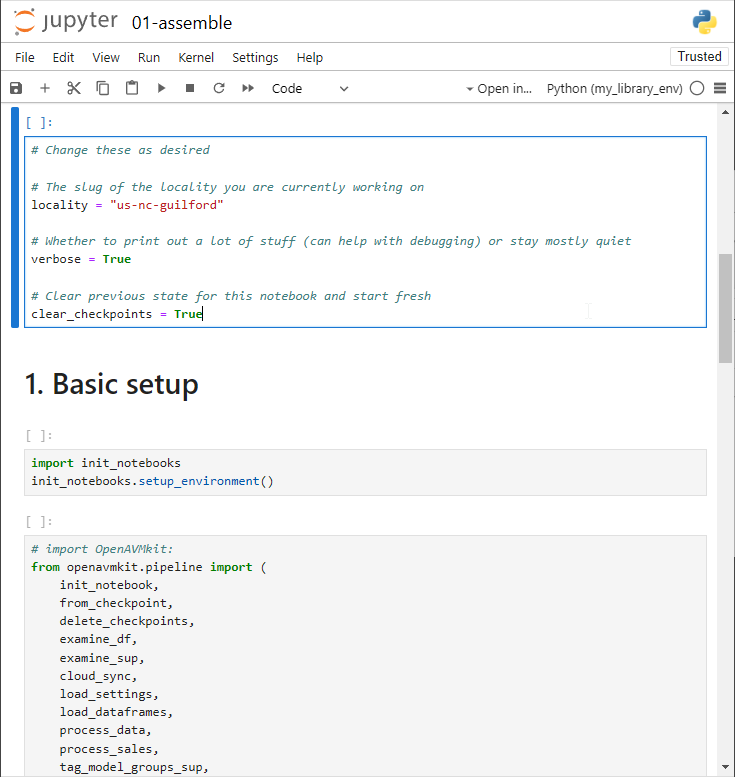The Basics
Creating a new locality
OpenAVMKit operates on the concept of a "locality", which is a geographic area that contains a set of properties. This can represent a city, a county, a neighborhood, or any other region or jurisdiction you want to analyze. To set one up, create a folder like this within openavmkit's notebooks/pipeline/ directory:
notebooks/pipeline/data/<locality_slug>/
Where <locality_slug> is a unique identifying name for your locality in a particularly opinionated format. That format is:
<country_code>-<state_or_province_code>-<locality_name>
-
Country code: The 2-letter country code according to the ISO 3166-1 standard. For example, the country code for the United States is
us, and the country code for Norway isno. -
State/province code: The 2-letter state or province code according to the ISO 3166-2 standard. For example, the state code for Texas is
tx, and the state code for California isca. -
Locality name: A human-readable name for the locality itself. This follows no particular standard and is entirely up to you.
-
No dashes except between the above: The dashes are used for separation, so please don't include any WITHIN e.g. your locality name. So
us-ny-new-york-cityis not a good idea, butus-ny-new_york_cityorus-ny-nycorus-ny-newyorkcityis fine.
The slug itself should be all lowercase and contain no spaces or special characters other than underscores.
Some examples:
us-nc-guilford # Guilford County, North Carolina, USA
us-tx-austin # City of Austin, Texas, USA
no-03-oslo # City of Oslo, Norway
no-50-orkdal # Orkdal kommune (county), Norway
Once you have your locality set up, you will want to set it up like this (using the non-existant us-tx-imaginarycounty as an example):
notebooks/
├──pipeline/
├──data/
├──us-tx-imaginarycounty/
├── in/
├── settings.json
├── out/
The in/ directory is where you will put your raw data files.
The out/ directory is where the output files will be saved.
The settings.json file will drive all your modeling and analysis decisions for the library. For now you can just start with a "blank" file that contains a single pair of open and close curly braces like this:
{}
That will be sufficient to get the file to load, but you will want to consult the documentation / tutorials for how to construct this file.
Code modules
Here's how you can import and use the core modules directly in your own Python code.
For instance, here's a simple example that demonstrates how to calculate the Coefficient of Dispersion (COD) for a list of ratios:
import openavmkit
ratios = [0.8, 0.9, 1.0, 1.1, 1.2]
cod = openavmkit.utilities.stats.calc_cod(ratios)
print(cod)
You can also specify the specific module you want to import:
from openavmkit.utilities import stats
ratios = [0.8, 0.9, 1.0, 1.1, 1.2]
cod = stats.calc_cod(ratios)
Or even import specific functions directly:
from openavmkit.utilities.stats import calc_cod
ratios = [0.8, 0.9, 1.0, 1.1, 1.2]
cod = calc_cod(ratios)
Using the Jupyter Notebooks
Make sure that you've already installed the jupyter library. If not, see Getting Started for instructions.
The notebooks/ directory contains several pre-written Jupyter notebooks that demonstrate how to use the library interactively. These notebooks are especially useful for new users, as they contain step-by-step explanations and examples.
- Launch the Jupyter notebook server:
jupyter notebook
This should open a new tab in your web browser with the Jupyter interface.

- Navigate to the
notebooks/directory in the Jupyter interface and open the notebook you want to run.

- Double-click on your chosen notebook to open it.

For information on how to use Jupyter notebooks in general, refer to the official Jupyter notebook documentation.
Terminology
Consider the word "property" -- is this furniture, a piece of real estate, or a characteristic like height? In layman's terms it could mean any of those. For the avoidance of confusion in cases like this, we take pains to choose very specific terminology.
Parcel
The fundamental unit of real estate. In this context, each row in a modeling dataframe typically represents a single parcel. In the context of OpenAVMKit, a "parcel" means a piece of land as well as any and all improvements that sit upon it. Think of it as a "package" of real estate.
Building
A freestanding structure or dwelling on a parcel. A parcel can have multiple buildings. A building is an improvement, but not every improvement is a building.
Improvement
Any non-moveable physical structure that improves the value of the parcel. This includes buildings, but also other structures like fences, pools, or sheds. The term "improvement" also includes things like landscaping, paved driveways, and, in agricultural contexts, irrigation, crops, orchards, timber trees, etc.
Model group
A named grouping of parcels that share similar characteristics and, most importantly, prospective buyers and sellers, and are therefore valued using the same model. For example, a model group might be "Single Family Residential" or "Commercial".
Characteristics
Characteristic
A feature of a parcel that affects its value. This can be a physical characteristic like square footage, or a locational characteristic like proximity to a park. Characteristics come in three flavors -- categorical, numeric, and boolean.
Categorical characteristic
A characteristic that has a defined set of values. For example, "zoning" might be a categorical characteristic with values like "residential", "commercial", "industrial", etc.
Numeric characteristic
A characteristic that can take on any numeric value. For example, "finished square footage" might be a numeric characteristic.
Boolean characteristic
A characteristic that can take on one of two values, "true" or "false". Example: "has a swimming pool" is boolean, whereas "size of swimming pool" is numeric.
Value
Prediction / Valuation
An opinion of the value of a parcel.
Full market value
The price a parcel would sell for in an open market, between a willing buyer and a willing seller when neither is under duress and both have equal information. In a modeling context, this is the value we are trying to predict.
Valuation date
The date for which the value is being predicted. This is typically January 1st of the upcoming year, but it can vary with locality.
Improvement value
The portion of the full market value due solely to the improvement(s) on a parcel. This excludes the value of the land.
Land value
The portion of the full market value due solely to the land itself, without any improvements. This excludes the value of any and all improvements.
Data sets
Data set
This refers to any collection of parcel records grouped together by some criteria.
Sales set
This refers to the subset of parcels that have a valid sale within the study period. We will use these to train our models as well as to evaluate them.
Training set
The portion of the sales set (typically 80%) that we use to train our models from.
Test set
The portion of the sale set (typically 20%) that we set aside to evaluate our models. These are sales that the predictive models have never seen before.
Universe set
The full set of parcels in the jurisdiction, regardless of whether the parcels have sold or not. This is the data set we will generate predictions for.
SalesUniversePair set
In any OpenAVMKit model, this refers to a data set created by merging together "Sales" set and the "Universe" set. We use this data structure to make sure that both the "sales" and "universe" data set are processed together in a consistent manner.
Modeling
Main
In any OpenAVMKit model run, the "main" model is the primary model. It operates on the full data set, and predicts full market value.
Vacant
In any OpenAVMKit model run, the "vacant" model is a secondary model that trains and predicts separately. It is trained only on sales of vacant land, but is used to predict the value of all parcels. The prediction it generates is solely for land value, not full market value.
Hedonic
In our specific usage, a "hedonic" model is a variant of the main model used to predict land value. In this case, the main model is re-used for a second set of predictions, but the universe dataset is manipulated to remove all the improvement characteristics. This causes the main model to predict the full market of each parcel as if it was a vacant lot.
Avoid these terms
These terms are ambiguous and can refer to different things in different contexts, so we avoid them in our documentation.
Property
In casual conversation this can mean a parcel, a building, or a piece of land. But in the context of coding, it can also refer to a characteristic or variable.